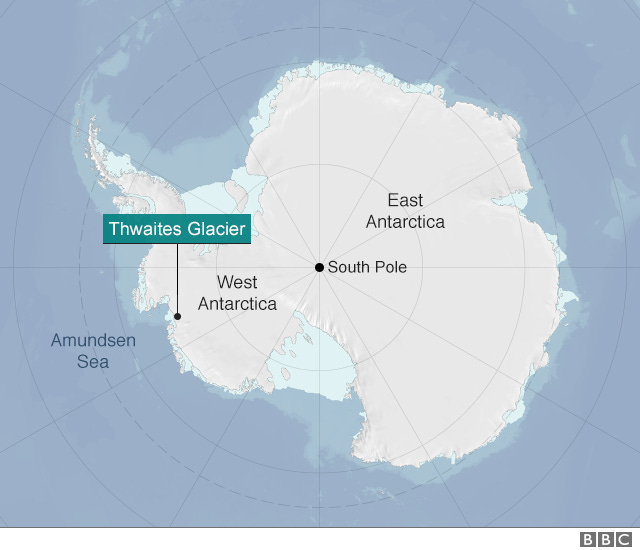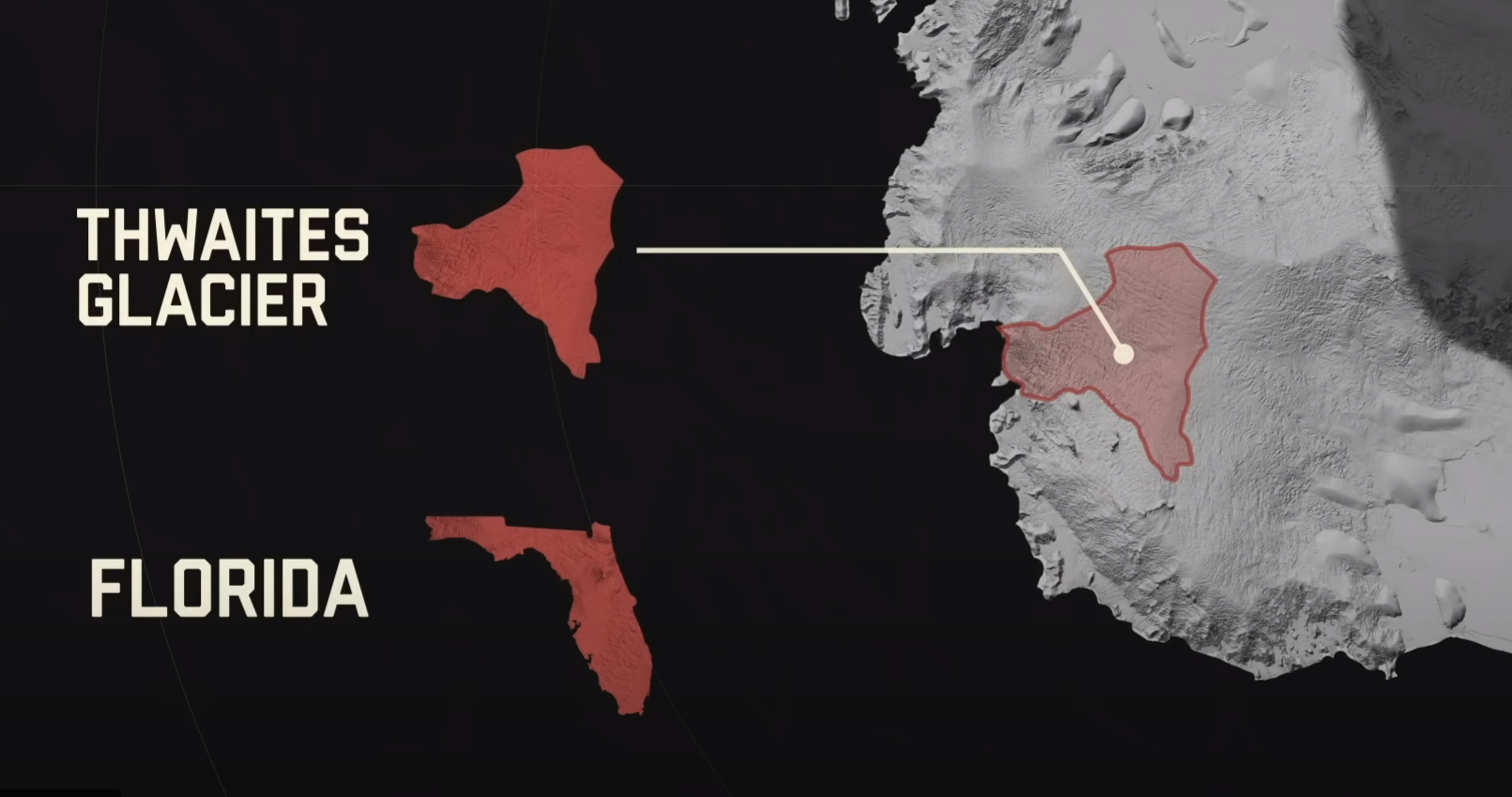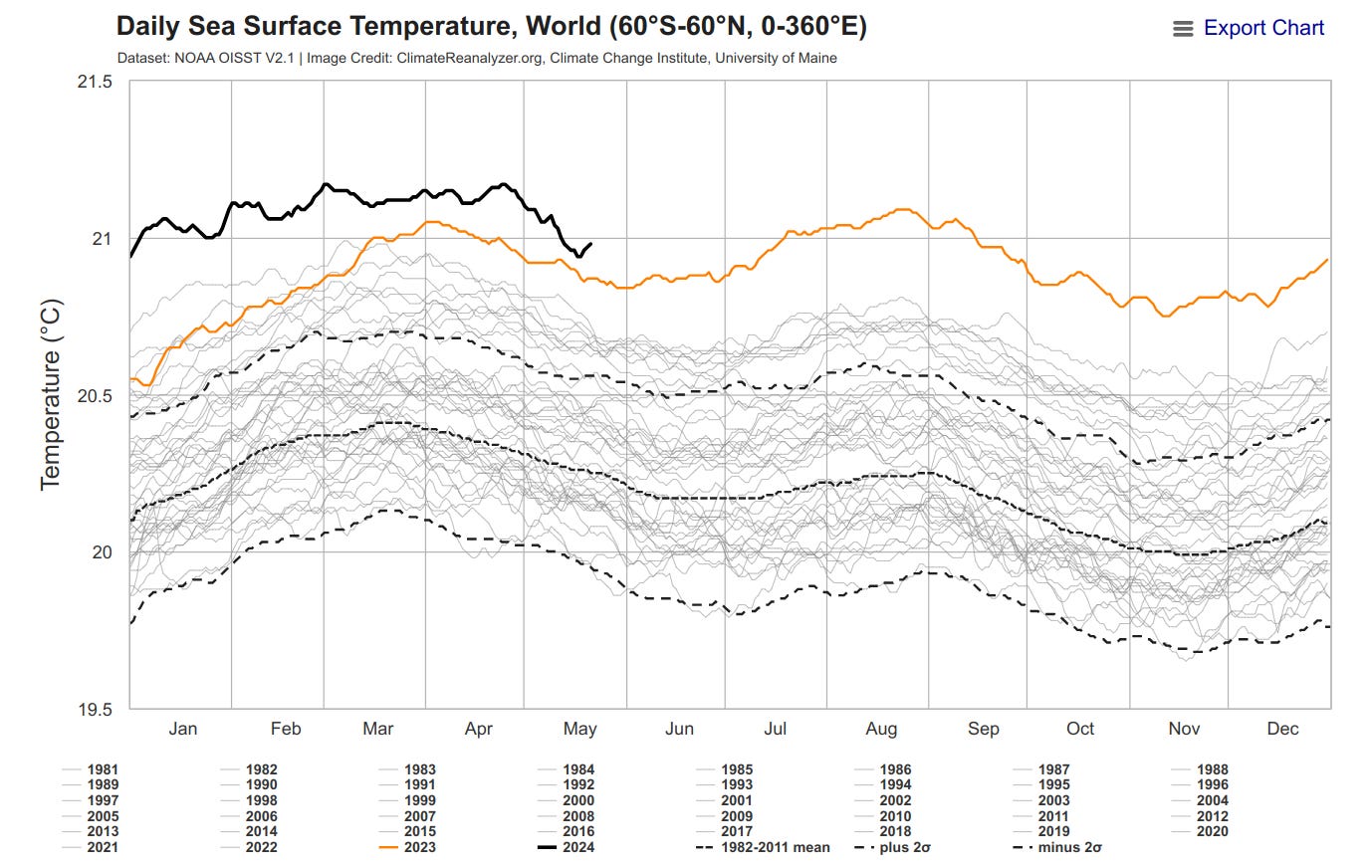Yves here. We have yet another cheery sighting on the state of global warming, in the form of a Thwaites Glacier update.
By Thomas Neuburger. Originally published at God’s Spies

Location of Thwaites Glacier in Antartica (source)
The Thwaites Glacier, a Florida-sized mass of ice at the coast of Western Antarctica, has been called the “doomsday glacier” because of its potential to wreak havoc all by itself.

Jump to the 2:29 minute mark to see a visualization of the undercutting in action.
“How soon that happens is hotly debated” says the narrator at 3:33. That was in 2020. Not so much anymore.
‘It will take decades, not centuries’
From CNN on May 21 (via the excellent climate news aggregator, The Collapse Chronicle):
Ocean water is rushing miles underneath the ‘Doomsday Glacier’ with potentially dire impacts on sea level rise
…Thwaites, which already contributes 4% to global sea level rise, holds enough ice to raise sea levels by more than 2 feet. But because it also acts as a natural dam to the surrounding ice in West Antarctica, scientists have estimated its complete collapse could ultimately lead to around 10 feet of sea level rise — a catastrophe for the world’s coastal communities.
Many studies have pointed to the immense vulnerabilities of Thwaites. Global warming, driven by humans burning fossil fuels, has left it hanging on “by its fingernails,” according to a 2022 study.
CNN doesn’t link to the study. The UC Irvine announcement is here. The paper itself is here.
The lead author, Eric Rignot, has been quoted as saying, “The projections will go up … [The collapse] will take many decades, not centuries. Part of the answer also depends on whether our climate keeps getting warmer or not”.
Needless to say, the climate keeps getting warmer. And don’t trust the word “many.” He’s trying not to scare you too much.
Our Bet with the Future
No one says this will happen immediately. “Decades” are still not next year. But global sea surface temperatures are setting new records, and at an accelerating pace.
As you can imagine, there’s a certain freaking out caused by this, more so from scientists (see also here and here) than from those who owe their lives to the moneyed class.
In how “many decades” could this all occur? My money’s on two or three, by the mid-2050s.
Global Sea Level Rise vs. Sea Levels Near You
But whatever the time scale for Thwaites’ complete collapse, the change it will bring won’t be smooth, but sudden, in stages. If a Florida-sized chunk of ice that’s not submerged, suddenly falls into the sea, it will raise sea level globally — on its own — by as much as two feet.
And that rise won’t be well distributed. The sea near New York, for example, will rise 1½ times the global average:
The Thwaites collapse, when it comes, will change everything. And the Western Antarctic collapse, following that, will ice the rest of the cake. The first could come in the next twenty years or so — remember, everything’s accelerating.
And the second … well, when that arrives may not matter at all, given how scrambled our eggs will be by then.
The Solution
The solution, of course, is action of a “vigorous” kind. The State knows this far better than most. That’s why it’s been gearing up. We’ll look at that soon.



So, what changes are needed and who needs to make them?
Best…H
Global see level rise in decade not centuries.
Who cares? It’s more important we spend hundreds of billions to destroy Russia and China (and what about Cambodia doing business w/China w/o asking our permission first such nerve!) and break them into dozens of small nations so that we can make them all buy iPhones, Facebook Outlook Excel Word and Power Point and make them install cable tv and watch the news and laptops, overpriced US electric cars that don’t work so well, hedge fund owned US medical care, US patented drugs not unsafe generics, pay royalties to Bill Gates every time they mouse click in excel or send a msg on Team.
The videos might serve some purpose for the elites however. It might get them to worry and have anxiety as they drive there expensive oversized cars to work and and make them drive faster and faster and faster into increasingly more congested traffic jams.
Such an optimist! No destruction of other countries, just billions of dollars of purchase orders for weapons we can no longer produce! With nuclear annihilation the moat around the doomsday bunkers! USA USA!
My guess: there will be “vigorous action” … for some lucrative definition of vigorous … when water is lapping at the doorstep in the toniest locations. Donnie’s swimming pool for example or erosion topples some palace in the Hamptons.
The disappearance of islands inhabitated by the equivalent of “deplorables” is beneath notice.
This will not raise ocean levels by 2 feet, less than an inch, maybe.
Nothing ‘doomsday’ about this glacier.
Do you have facts to back up your assertion? I’d like to see them.
Explain please.
The Thwaites glacier has a volume above flotation of 258,000 km3. To find the water volume of this ice in meters:
volume of ice x (density of ice/density of seawater), or 258,000 x [(917 kg / m^3) / (1025 kg / m^3)] x 10^9 m^3 / km^3
Water volume of this ice is: 231,060 x 10^9 m^3
Surface area of the world’s oceans is 3.618 x 10^14 m^2
Sea level rise = (231,060 x 10^9 m^3) / (3.618 x 10^14 m^2)
Sea level rise = 0.638 meters. Guess how many feet that is, roughly?
Well done
Math is a wonderful tool
This is a textbook example of the asymmetry of effort involved in refuting bulls**t.
Bulls**t: 90 characters
Refutation: 373 characters
Math is a wonderful tool if you use it correctly. You can’t divide a volume of the glacier (in m^3) by the area of the ocean (m^2) and get anything meaningful. If you want the correct ratio you need to divide the volume of the glacier volume (231,060 x 10^9 m^3) by the volume of the ocean (1.37E+18 m^3, from Wikipedia). if you do this you get 0.00017, or complete melting of the glacier would add 0.017% to the oceans on a volume basis. I don’t know what the equivalent sea level rise would be, but it wouldn’t be 0.638 m.
Phil R, your unit analysis is flawed. Most people are interested in mean ocean depth (units are length, m) not change in oceN volume (unitless), so dividing a m3 volume by a m2 area is correct.
Seems to me that if you are adding a volume to a flat surface area to get a height, you certainly would do it the way John did it.
If I have .5 cubic feet, and I am adding it to a surface area of 1 square foot, I divide .5 cubic feet by 1 square foot to get a height of .5 feet, which is what we know the answer would be. Trying it again with some easy numbers to prove the concept again, 1 cubic foot of volume spread over 4 square feet- 1/4= .25 feet of rise. Which again, matches what we would intuitively know to be correct.
The only thing John does not account for is the slope of the land away from the coastline, which would reduce the rise slightly. Other than that, I cannot fault his work. Granted, I was only a math minor.
Seems to me that if you are adding a volume to a flat surface area to get a height, you certainly would do it the way John did it.
Arkady Bogdanov
You are absolutely correct IF you are adding a volume to a flat surface, but you are not. You are adding a small volume of water (glacier melt) to a much larger volume of water (world’s oceans).
If I have a glass of water and put an ice cube in it, the water level in the glass rises because of the volume displacement of the ice cube. The ice cube doesn’t just sit on top of the water, elevating the water level in my glass by the thickness of the ice cube.
Similarly, the correct way to look at it is a displacement of the total ocean volume by whatever the volume of the glacier is, assuming complete melting. It doesn’t just spread out over the surface of the ocean.
If we focus on volume, we are short a step. Displacement of the total ocean volume doesn’t get the metric we are looking for: that would just be the water volume of the glacier in this case. We are looking for sea level rise. Since the water distributes itself evenly due to gravity (for our purposes, excluding more complex and precise factors), you are distributing the volume over the surface of the oceans.
John, you’re absolutely right, my bad. If I have an excuse it’s because I was at work and in a hurry. I was thinking about it on the way home and realized I needed to make one more step that I missed. I needed to take the volume ratio that I calculated and multiply it by the average ocean depth. I just did this when I got home and got 0.622 m, which is close enough to your original calculation (jiust slightly different input values). Yours was a shortcut that I missed. Thanks for the gentle correction.
All good! Definitely got me thinking about it which is a good thing. Stretching muscles I haven’t used in a while.
I suspect what you are getting at with the ice cube thing: a floating piece of ice already displaces it’s own volume in water. However, the Thwaites Glacier is not floating but is grounded. Therefore melting adds new water to the ocean which is not already accounted for by water displacement, leading to an increase in sea level.
“I don’t know what the equivalent sea level rise would be, but it wouldn’t be 0.638 m.”
The equivalent sea level rise would be dependent upon the surface area. If you add 1 cup of water to another container A which already contains 2 cups of water, the water level rise would change depending on whether A is a coffee mug or sauce pot. Simply comparing volumes without specific dimensional data won’t be enough.
And I was wrong here, too.
If this glacier appears to melt and sea level appears to rise the way this article appears to claim, you will have a better-than-ever contrarian investing opportunity handed to you on a diamond platter. When the chicken littles are all fleeing from the so-called “rising” sea level, you will be able to buy seaside property at pennies on the benjamin and once people realize the sea isn’t really rising at all and it never was . . . or maybe it starts falling again . . . or something, you will be able to sell that land back to embarrassed returnees at benjamins on the penny.
You really should buy all the coastal land you can in Florida and Louisiana. And I sincerely hope you do.
Going back to the end of the last Ice Age, around 8000 BCE, there was a break in the ice in the North Atlantic, which led to the flooding of the Dogger region in the North Sea, the separating of England from France, the separating of Japan from Korea, the flooding around Australasia. Some of this took years but the flooding in the north took only weeks.
Should the Thwaites glacier suffer from low level melting, it could well quickly slide into the ocean, creating a tidal wave and earthquakes
At this stage of the game, I would expect that there would be more corporate effort in working out ways to profit from sea level rising than actually doing something about that. Thus for example, there is mention of how New York will get hit bad. So there would be pre-thought going into how to build some huge engineering scheme to protect New York – or at least Manhattan – that will cost hundreds of billions of dollars and take decades to build. It would involve the government financing all these engineering corporations and paying their bills while they make out like bandits. And that is the point. It would not matter if such a scheme even worked but the true purpose of such schemes is to funnel a deluge of federal money into private coffers so that they can become even more wealthy.
Industrial society and its consequences…
Also somebody didn’t close an “em” tag everything is italic…
lets test it :)
this should be non italic
Capitalism: Let us destroy everything before somebody else does
Missing somewhere, likely in the Neuberger attribution.
The final paragraph of this post contains some interesting links including the first reference to the Atlas Network I have seen in a while.
We should use the time now, while it is still possible, to acknowledge what is coming and clean up nuclear facilities along sea shores as well as the worst toxic dumps and storage facilities which are also vulnerable. Once the sea level rises all that poison will be inaccessible and quickly swept up by ocean currents. Nobody seems interested in taking that responsibility. Hard to believe.
Well . . . George Walker Bush bought a 200,000 acre ranch in Paraguay atop the world’s biggest aquifer.
So why would he bother taking any responsibility at any level for even agitating to clean up those coastal hazards in North America? https://watchingamerica.com/WA/2015/06/18/bush-family-buy-up-guarani-aquifer/
( this article describes it as several Bush family members, not just Shrubya himself).
And he is just one example. Thiel in New Zealand, etc. etc. etc.
Why would any of them care?
“Hard to believe.”
Is it really that hard to believe?
I cannot believe much … but I can believe nuclear energy generation facilities, waste dumps, and waste storage facilities are ‘vulnerable’, that is neither ‘profitable’ nor ‘sufficiently punishable’ for financially considerable persons [not necessarily human persons] to worry about.
It’s the rule of threes: anything more than three years in the future we refuse to believe in, and will not plan for; anything more than three months in the future is unimportant right now, so we prefer not to plan for it.
Is it just me, or is the CSS for this page doing odd things today?
Why are all the comments in italic
World we know is toppling over
I’m not getting that in Safari or Firefox. Having said that, Substack posts are FULL of junk code and it is a bitch to strip it out without causing formatting weirdness.
Now it’s fine. Whatever was wrong yesterday, is fixed in the meantime.
The climate fiction novel New York 2140 by Kim Stanley Robinson had some cool perspectives on how our society might respond (from a capitalist position) to rising sea levels. There was even a main character who worked in property speculation, and another using social media to rehome wild animals. Felt pretty fresh and believable when it first came out.